2022 | OriginalPaper | Buchkapitel
10. Information and Utilisation of MSP: Major Determinants
verfasst von : Poornima Varma
Erschienen in: Pulses for Food and Nutritional Security of India
Verlag: Springer Nature Singapore
Aktivieren Sie unsere intelligente Suche, um passende Fachinhalte oder Patente zu finden.
Wählen Sie Textabschnitte aus um mit Künstlicher Intelligenz passenden Patente zu finden. powered by
Markieren Sie Textabschnitte, um KI-gestützt weitere passende Inhalte zu finden. powered by
